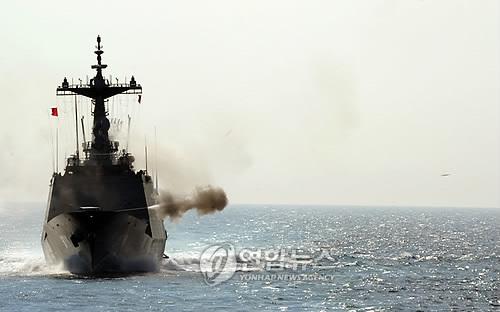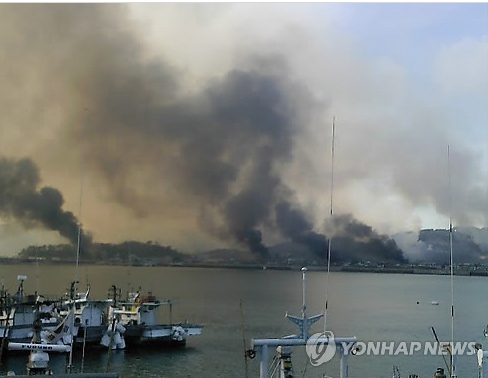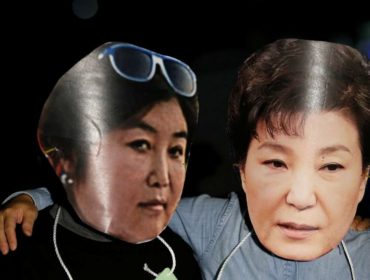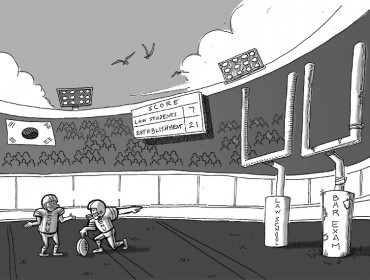Cartoon by Lee Scott & Writing by Iwazaru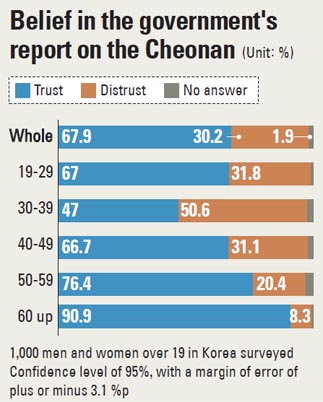
Editor’s Note: As the one year anniversary of the March 26 Cheonan tragedy arrives, The Three Wise Monkeys will look back at stories covering the events after it happened. 3WM believes the attack was the work of Kim Jung-il and the North Korean military. However, the skeptics are still calling for the “truth.”
And a recent JoongAng Ilbo poll showed that some 30%of South Koreans doubt the government’s explanation.
R.I.P. Cheonan Sailors
April 26,2010
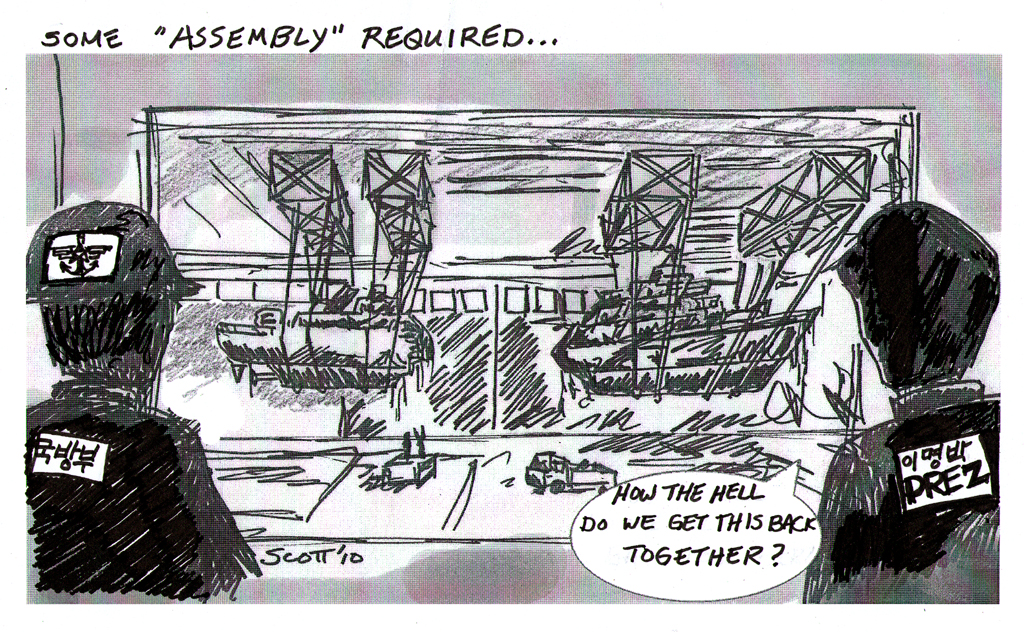
As South Korea spends five days officially mourning the sailors who perished in the sinking of the Cheonan, the nation and world are waiting for the official cause to be announced.
Over the weekend Defense Minister Kim Tae-young said that a torpedo was the most likely cause setting off more speculation about “who” would fire a torpedo in the Yellow Sea and why.
The call for calm calculation and consensus seems to be most common among the mainstream but there are certainly those demanding a “stern” response as President Lee said in a tearful speech more than a week ago.
Yet the problem remains what to do and how to do it. With the funeral of the fallen to take place on Thursday, there is a belief that the collective voice calling for an answer (and response) will rise.
Now that the U.S. has come out and said it believes it was a torpedo as well one can only expect that something will come to a head sooner than later.
South Korean Government in Cheonan Conundrum
May 24, 2010
Nearly two months after the sinking of the Cheonan warship in the Yellow Sea that left 46 South Korean seamen dead, the government came forward on last Thursday morning with detailed evidence (including recently recovered parts of the torpedo used with written Korean characters and an accompanying blueprint of the torpedo taken from a weapons brochure the North offers to potential customers) presented in a lengthy press conference that points the finger at North Korea. (North Korea offered to send its own “investigative team” after denying all accusations.)
All of this data laid out how the ship was sunk by a midget submarine that had been deployed from a larger mother ship, both having been detected leaving a nearby naval base a few days before and returning a few days later.
Now comes the hard part: what to do? As the Economist said, the government’s options are “puny” and risky. Things are already tense since South Korean President Lee Myung-bak entered office and reversed the “Sunshine Policy” advocated by both former presidents Kim Dae-jung and Roh Moo-hyun that called for aid and nonconfrontational actions with the hopes of “warming” North Korea and getting it to open up. Lee refused to kowtow and has settled for a quid pro quo stance. The opposition Democratic Party says the results are a sham and suggests a rock or collision with a U.S. vessel sunk the ship.
One can surmise that Lee will continue his stance and respond with something that his predecesors might not have. A s the U.S. military’s Stars and Stripes says there are “no easy options” because the developed South has much more to lose than a destitute North that would surely unleash its military might.
s the U.S. military’s Stars and Stripes says there are “no easy options” because the developed South has much more to lose than a destitute North that would surely unleash its military might.
Yet, if nothing is done, there is the risk that the North may think that it can roam the waters with impunity (and when would be the next attack?).
In addition, China looms large in the equation as it apparently isn’t going along with the evidence presented. Many believe the more significant concern is driving North Korea into China’s arms and further away from any future unification. There is an underlying and mostly unspoken suspicion in South Korea that perhaps China has ideas of a North Korean “colony” under Chinese control in the future. How China reacts will be under much scrutiny.
The six-party talks have remained “dead” as North Korea called them but there remains hope—China reportedly pushed Kim to return to the talks on his recent trip to Beijing—that the talks can facilitate detente and the eventual denuclearization of the peninsula. Apparently North Korea has accused the U.S. of trying to “stifle” it (and the six-party talks) by siding with South Korea in the Cheonan incident.
Nevertheless, “something” will have to be done by the current administration even if it’s mostly ineffective as almost all previous “responses” to North Korean hostilities and acts of war have been. The report that the U.S. Navy’s Seventh Fleet out of Japan will participate in a “massive” exercise in the Yellow Sea next month seems to be an indication that the military is prepping to put on a show of force.
A Sunken Ship & a President’s Suicide: the Dynamics of a South Korean Election
June 3, 2010
By Iwazaru
The local elections here in South Korea to pick about 4,000 posts, including provincial governors, mayors, councilors and education chi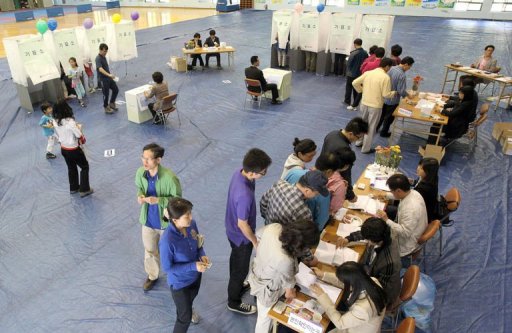 efs took place on Wednesday and the results were watched closely by many as a harbinger of the political future and a referendum on the conservative government led by President Lee Myung-bak.
efs took place on Wednesday and the results were watched closely by many as a harbinger of the political future and a referendum on the conservative government led by President Lee Myung-bak.
As I pulled up a chair next to Korean colleagues at one of the lunchroom tables in my school, I heard mentions of the results which had the liberal Democratic Party (DP) winning seven mayoral and gubernatorial posts, while the ruling Grand National Party (GNP) secured six seats, including Seoul mayor, according to preliminary results.
The lead-up to the elections was fraught with interesting external elements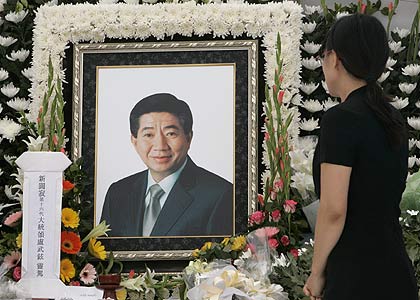 including the sinking of the Cheonan naval ship, the one-year anniversary of the suicide of former liberal president Roh Moo-hyun and several policies of President Lee (specifically a project to develop four rivers and a plan for a “new” educational, scientific and business city south of Seoul).
including the sinking of the Cheonan naval ship, the one-year anniversary of the suicide of former liberal president Roh Moo-hyun and several policies of President Lee (specifically a project to develop four rivers and a plan for a “new” educational, scientific and business city south of Seoul).
“What happended?” I asked the middle-aged Korean man sitting across from me at the lunch table who teaches German grammar. “People are upset that the president is lying about the Cheonan,” he answered, continuing the assertion he had been making that the ship was not sunk by North Korea. (He offered no alternate theory but it was clear he thought the U.S. military was involved and he pointed me toward one conspiracy theorist.) When I mentioned that apparently many young people had come out to vote, he said “Of course, the young people are smart and know that the president is lying and pursuing bad policies.”
The victory for the DP indicates any number of things—some known and unknown—but certainly it is a mid-term referendum on President Lee that could throw a wrench in his policies and it would seem to fly in the face of hard-line North Korean policy. Perhaps people aren’t so angry about the sinking of the ship as B.R. Myers points out sagaciously in his “South Korea’s Collective Shrug.”
Understanding modern South Korean politics requires a deeper understanding of regional loyalties, sympathy for and ethnic connection with the North, and the influence of the two former presidents Roh and Kim Dae-jung. And that is just the beginning.
From here, how things will play out is uncertain but President Lee is certainly not celebrating and the walls of the Blue House might start whispering “lame duck” as the opposition party finds its sails filled with the winds of victory. As my liberal Korean colleague said of the 2012 presidential election, “there is a change coming.”
High Court and Drama at UN over Cheonan
June 17, 2010
By Iwazaru (Cartoon by Lee Scott)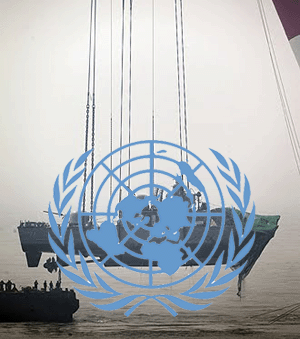
Now that both Koreas have presented their cases to the United Nations Security Council regarding the sinking of the Cheonan, it is time to see if any kind of consensus and consequences will follow, though it already seems unlikely that it will matter.
North Korea, in typical form, threatened that its response to any punishment meted out by the UNSC “will be carried out by our military forces.” It continues to claim that it had nothing to do with the sinking and that the whole thing is “a complete fabrication from A to Z.”
Even the North’s ambassador to the United Nations, Sin Son-ho, oddly offered that he would lose his job if the UN weighs in favor of the South much like an attorney who fails to plead his case. Sin implored the Security Council to remain impartial and not ruffle the North’s feathers. He compared the South’s claims to Aesop’s fables saying, “This is indeed as funn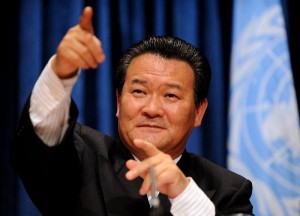 y story as some kind of fiction in the Aesop’s Fables.”
y story as some kind of fiction in the Aesop’s Fables.”
One can surmise that the North is elated by the news that the South Korean civic group the People’s Solidarity for Participatory Democracy (PSPD) submitted its own letter to the UN questioning the South Korean government’s claims with eight questions that are “needing answers.” Such a bold, public refutation of the government’s claims has exposed the PSPD to some backlash from veteran groups in the South and an investigation related to national security by the Seoul prosecutors.
Last week, an interesting twist was thrown into the South Korean military’s reaction to the March 26 emergency which had already been beleaguered by accusations that it was unprepared and inept in dealing with the sinking. Reportedly, one of the generals in charge had been imbibing on the evening after attending an official meeting and showed up to an emergency meeting at the command center intoxicated. The general has stepped down but maintains that he was misrepresented by the news report and intends to sue.
In addition, the Board of Audit and Inspection which targeted the general 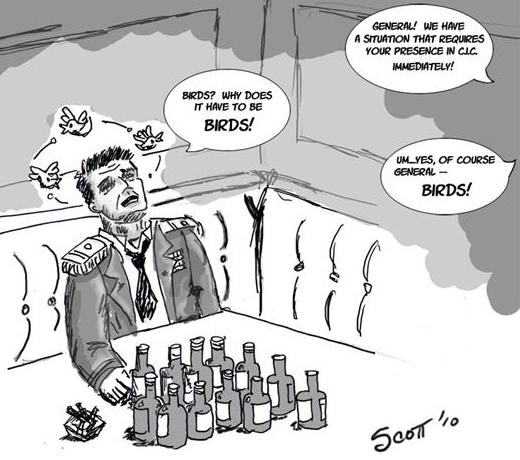 said that the report that a second naval ship, the Sokcho, that arrived near the scene after the sinking and fired 130 rounds at a target to the north of the location had not initially said it was “birds” but instead said they thought it was an enemy vessel. This story shows the earlier report with an excellent map of that night’s events. Apparently, the Sokcho’s report that they thought they had an enemy target was changed in the report to say it was only birds.
said that the report that a second naval ship, the Sokcho, that arrived near the scene after the sinking and fired 130 rounds at a target to the north of the location had not initially said it was “birds” but instead said they thought it was an enemy vessel. This story shows the earlier report with an excellent map of that night’s events. Apparently, the Sokcho’s report that they thought they had an enemy target was changed in the report to say it was only birds.
All in all, some intrigue remains as to how the UN will deal with the smoke-and-mirrors sideshow that the North and conspiracy theorists have trucked into the New York headquarters. Heavy sanctions are already in place and it is not clear how much more could be done—perhaps some sort of joint declaration condemning the act is as far as the UN will go. China is clearly in no mood to take sides because of its interests.
However, Russia surprisingly made statements yesterday, June 17, that it’s continuing its analysis of the South Korean government’s evidence of the sinking and will make it’s final position known in a few weeks. Experts have speculated that Russia has nothing to gain by siding with the South and lots to lose if it goes against the North. Others say that Russia’s economic interests and ties with the South are set to strengthen considerably following the G20 Summit to be held in Seoul in November.
The Machinations of Modern Diplomacy—the Cheonan Aftermath
July 19, 2010
A Chinese businessman recently in Pyongyang reportedly snapped a picture of a propaganda poster that shows a naval soldier smashing a ship in half with the words below the image stating “Deom-byeo-deul-myeon Dan-mae-e!” (“Ready to crush any attack with a single blow!”).
Radio Free Asia reported the story and released the photo and comments from the businessman who wished to remain anonymous. In addition, the report referred to comments made by a South Korean military expert who said the ship isn’t just any random vessle but a corvette just like the Cheonan which was blown in half on March 26 killing 46 sailors. A multinational international investigative team presented evidence that pointed to a torpedo fired by a North Korean submarine, though intrigue has lingered along with North Korea’s denial of involvement.
After the two Koreas presented their cases to the UN Security Council, it was unclear what, if anything, the Council could or would do. The result was a rather ambiguous statement condeming the attack on a Republic of Korea vessle with no mention of the perpetrator in name (there was a mention of the the North’s plea to the UN that it “had nothing to do with the incident”). North Korea welcomed the UN statement as a “victory” and surely a sign that China remains a steadfast ally which surely has some shifting in their seats. Still there are diplomatic insiders who see the statement as a victory for South Korea and its allies given that China and Russia at least signed on
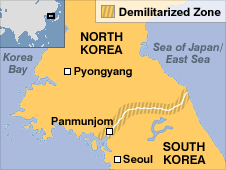 Since the statement the North Koreans requested a meeting with the U.S.-led United Nations Command which was subsequently held on July 15 at the truce village of Panmunjom which lies on the border between the separated countries. Reportedly the meeting between colonel-level representatives lasted an hour and a half and mainly concerned a general-level which would be held at a date to be announced.
Since the statement the North Koreans requested a meeting with the U.S.-led United Nations Command which was subsequently held on July 15 at the truce village of Panmunjom which lies on the border between the separated countries. Reportedly the meeting between colonel-level representatives lasted an hour and a half and mainly concerned a general-level which would be held at a date to be announced.
All of this has taken place while the U.S. and South Korea plan military drills, something that has been underway for several months. The off and on status of the large scale drills which will include an aircraft carrier, the U.S.S. George Washington, is indicative of the sensitivity and calculation that is involved. China has already said it opposes any military drills off its coast and it would seem that such opposition is being considered.
Yet, as of today it has been announced that several destroyers along with the George Washington will visit Busan from July 21 to 25. Moreover, U.S. Secretary of Defense Robert Gates and Secretary of State Hillary Clinton are scheduled to arrive in Seoul mid-week to hold a high-profile meeting with their counterparts here; many expect the formal announcement of the military drills during the visit. The AFP has quoted a high level U.S. defense official saying the drills would be carried out over “a period of months.” This certainly could tie in with the other announcement over the weekend that the U.S., Singapore, Japan and Australia will join South Korea for an 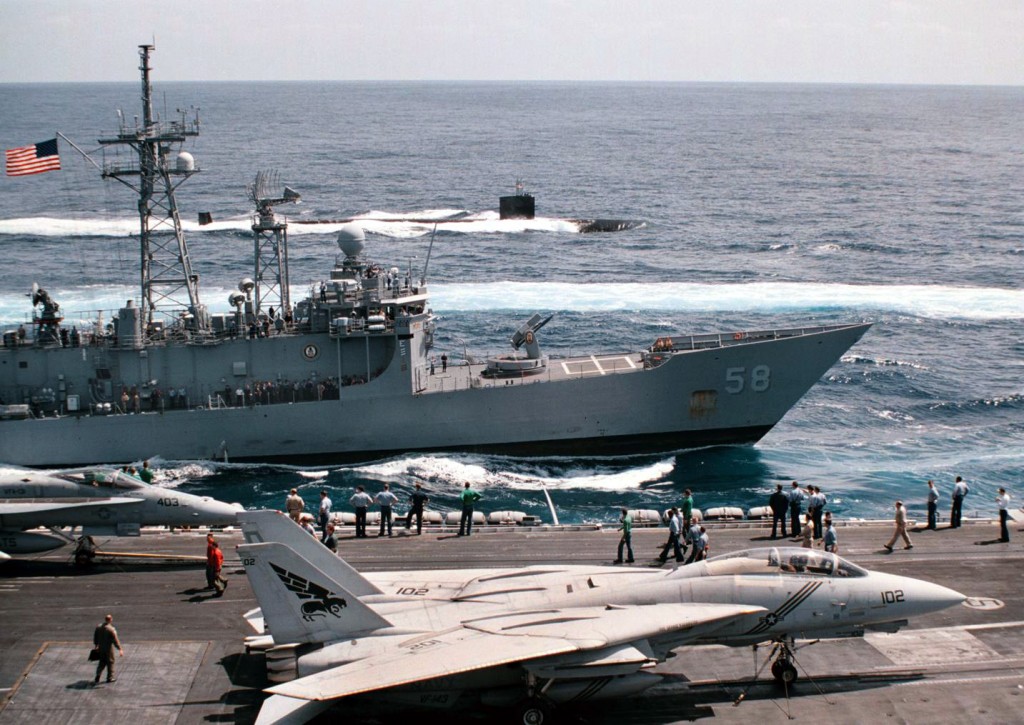 anti-proliferation drill off of Busan in October. The drill is related to the Proliferation Security Initiative (PSI) which aims to to prevent the shipping of weapons by stopping vessles that are suspected of carrying them. North Korea, a known arms dealer, previously reacted to South Korea’s joining of the initiative by saying it was a declaration of war.
anti-proliferation drill off of Busan in October. The drill is related to the Proliferation Security Initiative (PSI) which aims to to prevent the shipping of weapons by stopping vessles that are suspected of carrying them. North Korea, a known arms dealer, previously reacted to South Korea’s joining of the initiative by saying it was a declaration of war.
However, as the heat rises, a carrot in the form of New Mexican Govenor Bill Richardson may be in the mix. The JoongAng Daily reported that North Korea had invited Richardson—an old hand at foreign policy missions from Cuba and Sudan to North Korea (he’s visited six times)—to visit to discuss diverse diplomatic issues. Apparently the invitation was offered in May by a North Korean ambassador to the UN (Richardson is a former UN ambassador himself).
Whatever happens in the next few months it is clear that all players have interests of their own and for the region. China is not happy that the U.S. will be practicing war outside its back door and it’s fairly certain that they’re not happy with the Cheonan sinking (their public ambivalence is a necessary evil). They need stability for the economy to keep rolling and for North Korea to stay afloat less swarms of refugees flood their border.
Russia also doesn’t want to see U.S. military exercises in its backyard and it really doesn’t have much to gain by castigating the North. Remnants of the Cold War remain (despite rumors of their death) and it was the USSR that trained and put Kim Il-sung into place thereby establishing the cult of personality that exists today.
The U.S. in some senses benefits from having a reason to conduct such drills—along with a reason to maintain a presence in the region—but it also doesn’t want war. It seems fairly evident that an opened and developing North (without nukes) would be more preferred by the current administration.
South Korea needs economic stability as well but it appears that the era of detente (if it even was that) left North Korea with nuclear weapons, a sustained regime and an equally unpredictable military strategy. Some sort of foot needs to be put down.
North Korea remains as reclusive and Byzantine as ever, plotting and scheming to maintain it military first policies and its juche or self-reliance principles. If it is true that the sinking of the Cheonan was related to the changing of leadership with Kim Jong-il handing over the reins of a rickety wagon to his youngest son Kim Jong-un, then the show goes on and the curtain could be raised on the third act.
Everything remains to be seen.
Aftermath of North Korean Attack: South Korea to Test-fire Artillery; Japan, South Korea in Washington
December 6, 2010
Less than a week after the joint military exercises with the U.S. in the Yellow Sea, South Korea’s new defense minister, Kim Kwan-jin, is aggressively assuming his post.
Last Friday at the National Assembly Kim declared that the North would face aerial bombardment if it launched any future attacks, adding that the enemy should be “punished thoroughly.” Government sources have been consistently saying that another attack is likely citing evidence of a military buildup by the North near the 38th parallel.
Over the weekend Kim visited Yeonpyeong Island to get a firsthand look at the damage inflicted by the North’s shelling. At the same time residents were starting to return to the island to try to assess the damage and see what can be rebuilt. The government plans to compensate victims for damage but first people need to return to officially report what damages occurred. (The problem is few have returned and some may not.) The National Assembly already passed legislation for reconstruction and fortification of the five frontline islands.
In related news, the military has announced that it will conduct live-fire exercises at 29 different locations off all three coasts this week including Daecheong Island in the Yellow Sea. This has raised some anxiety as live-fire exercises near Yeonpyeong Island are the reason North Korea says it shelled the island.
More calls are coming for the military to bolster its forces–the latest has come from the Commission for National Security Review which advised President Lee to expand the Marine Corp, the toughest of Korea’s tough.
Meanwhile, Japan and South Korea’s foreign ministers are in Washington this week to discuss how to deal with North Korea’s aggressive and vexing actions. The three allies will certainly be discussing the readiness of their militaries and their ability to fight as one. Following the Yellow Sea exercises last week, the U.S. and Japan are holding the “Keen Sword” exercises on mainland Japan, Okinawa and in coastal waters through December 10.
All in all, from Seoul, it feels likes things are ratcheting up in the region. If anything, the attacks on Yeonpyeong revealed numerous chinks in the South’s armor that weren’t apparent following the sinking of the Cheonan: howitzers that don’t work, bomb shelters that are ill-equipped and outdated, soldiers that seemed unable to hit a target and a chain of command that sent our mixed messages. In addition, it showed that while the Sunshine policy flooded the North with aid, the South’s military was neglected and in some cases, allowed to rust.
___________________________________________________________
ORIGINAL REPORT
Reports from local and foreign press say that North Korea has shelled Yeonpyeong Island off the west coast of Korea along the disputed maritime border starting at 2:34 p.m. Tuesday, November 23.
Apparently more than 1000 Koreans reside there. Reports say a thousand Korean Navy sailors are posted on the Island (a nationwide military drill called the “Hoguk”–defense of one’s country in Korean–began yesterday).
President Lee Myung-bak has convened an emergency meeting at a bunker under the Blue House while, reportedly, fighter jets have been scrambled.
As of 5 p.m. one South Korean soldier has been reported dead while four soldiers were wounded. Residents have been evacuated to safe houses.
“Houses and mountains are on fire and people are evacuating. You can’t see very well because of plumes of smoke,” a witness on the island told South Korea’s YTN television station.
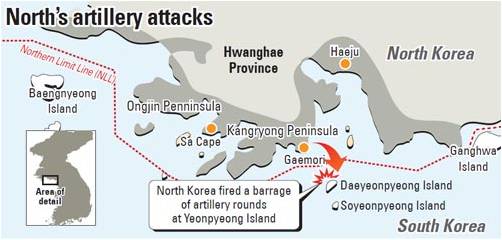 The island has been the location of skirmishes in the past with the last occurring in 2002 where both sides suffered casualties in a naval clash.
The island has been the location of skirmishes in the past with the last occurring in 2002 where both sides suffered casualties in a naval clash.
B.R. Myers, a North Korean expert, offered a insightful look into the situation as it is.
<UPDATE>
As of Wednesday, November 24, it is reported that two marines were killed in the shelling on the island. Lt. Gen. Lee Hong-ki, head of military operations at the South’s JCS, released the details.
The general confirmed that two marines, Sgt. Seo Jeong-woo, 24, and Pvt. Moon Kwang-wook, 20, who were stationed at the island’s Howitzer installation died from related injuries while being transported to a hospital in Seoul by helicopter. Six were seriously injured and 10 others suffered minor injuries, he added. Three civilians were also reported to have been hurt, with 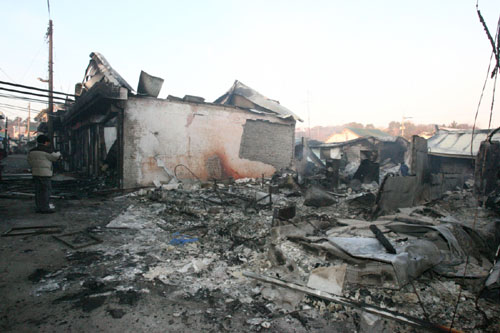 two people, an elderly and a schoolgirl, missing.
two people, an elderly and a schoolgirl, missing.
Two civilians were also found dead at a construction site Wednesday.
South Korea has announced that it will suspend any aid to the North and strengthen its firepower. America and South Korea also announced that they will go ahead with a four-day military drill in the Yellow Sea beginning Sunday that will include the the aircraft carrier USS George Washington.
Meanwhile, North Korea claimed that South Korea started the conflict by firing into its side of the maritime border during the Hoguk military exercises.
Washington has “condemned” the action calling it “belligerent” and reaffirming it’s support for and alliance with the South.
On the streets of Seoul things proceed as normal although there is a new sense that something has changed given the fact that civilians were targeted as well. Some people say that this is different from the past when only military targets were hit or government officials targeted. One person that 3WM spoke to mentioned the Axe Murder Incident in August of 1976 when two American military personal were killed in the DMZ during a “tree-trimming” operation. Experts say that the incident was a move to prove Kim Jong-il’s power within the North. Some people in the South are saying that this latest attack has something to do with Kim Jong-un’s recent appointment to Daejang, the same as a Four-Star General in the U.S. In a sense they believe this was carried out under his order.
A new report claims just this saying that on Monday Kim Jong-il and Kim Jong-un visited the coastal artillery 
base in Gaemori where the shells were fired from. Though none of this has been confirmed and the source remains anonymous.
In one high school classroom, students spoke of “fear” and “uncertainty” due to attacks on civilians which they’d never seen before. One boy said, “We don’t know what they’ll do next if they went this far this time.”
Asked about the proper responses, many students hesitated offering any kind of answer. When asked if the response from the government had been proper the majority said there should have been a heavier bombing at least to an equal magnitude of what the North used (the North fired roughly 100 artillery shells, and the South responded with around 80). Most just wanted things to remain normal.
Yet what one sees amongst the younger generation is a general lack of knowledge of the history with the North. It’s kind of like the neighbor next door that no one knows much about and doesn’t have time to be concerned with. There are things to do. Most students are worried about the next test. The Korean War is like a far off foreign place. When, why and how it happened is of little concern. It is history in the most pejorative sense of the word.
Businesspeople are more concerned with the bottom line and the next deal. The plunge of the markets after the attack had most people checking their stocks and worrying about the future impact (luckily, the Kospi bounced back on Wednesday). There seems to be mostly a feeling of, “Oh, them again; why are they doing this again?”
Teachers at one monkey’s school joked on the day of the shelling that people needed to leave the office early and get home to a safe place. Strangely the office was mostly vacant–except for the monkey and the vice principal–by 5 P.M. Life goes on. At least for now.
 Print This Post
Print This Post
<UPDATE Thursday, Nov. 25>
As residents of Yeonpyeong Island arrived on the mainland Wednesday and Thursday the Korea Coast Guard and firefighters checked houses and buildings, looking for casualties.
Members of the Coast Guard said about 370 residents were moved to the mainland by fishing boats leaving behind their damaged town. According to government statistics, 1,756 residents live on Yeonpyeong Island.
Local officials said the water supply was normalized Wednesday afternoon, while Red Cross workers started supplying free meals for residents this Thursday morning. Mobile phone services have been recovered, but fixed phone lines remain down. A state-run power company dispatched engineers to restore electric power facilities for civilians and military outposts on the island. The BBC provided an aerial view video clip showing some of the damage.
As announced Wednesday, the military drills set for the Yellow Sea–the front yards of China, South Korea and North Korea–will take place starting Sunday, November 28. The nuclear powered USS George Washington set sail from a naval base south of Tokyo on 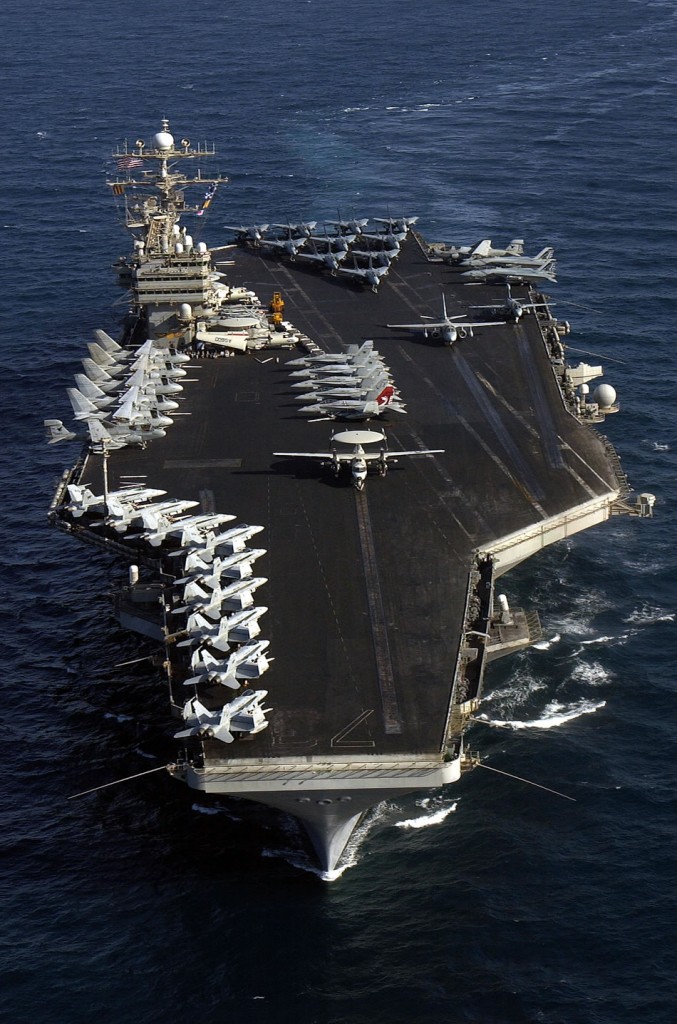 Wednesday with 6,000 sailors and aviators and 75 warplanes along with four companion ships and at least one high-tech attack submarine.
Wednesday with 6,000 sailors and aviators and 75 warplanes along with four companion ships and at least one high-tech attack submarine.
China is certainly pulling its hair and wringing it’s hands as it deals with an unwanted upping or the ante by North Korea. A tacit, well behaved North is in the best interests of China yet it again has the recalcitrant problem child stirring up the fire on the peninsula and in the region with its revelation of a uranium enrichment plant to Dr. Siegried Hecker of Stanford Univeristy (and a former director of the Los Alamos National Laboratory) and its shelling of a South Korean island. Now it is more difficult for the Chinese to protest about America’s presence in the region as a strong ally with the threatened South. North Korea’s renewed threats today don’t help.
Former president Jimmy Carter had an op-ed published in the Washington Post that asks for Washington to heed the North’s “consistent” message that it wants to talk directly with the U.S. to arrange a deal to denuclearize.
On a somewhat similar wavelength, North Korean pundit Andrei Lankov published a piece in the International Herald Tribune calling the North “the world’s most Machiavellian” regime that is adeptly using hostile acts to get people to “negotiate” i.e., pay up. He is less optimistic than Carter but both think it is time to sit down and come to some sort of agreement to prevent further provocations.
On the ground in Seoul national lawmakers are calling for some heads to roll due to the inept response to the shelling and overall lax defense of the military. Some lawmakers from President Lee’s ruling Grand National Party even called members of the administration “bastards” because there was advice that the president needed to prevent an escalation.
<UPDATE>
Explosions occurring on the North Korean coast near Yeonpyeong could be heard on Friday afternoon. Reportedly they were related to training the North is conducting. Nevertheless, those remaining on the island are on edge and reportedly fled to bunkers for safety. The South Korean military, on the highest alert level, is carefully monitoring the activities.
President Lee selected Kim Kwan-jin as the new defense minister to replace Kim Tae-young. The 61-year-old Kim Kwan-jin graduated from the Korean Military Academy in 1972 and was the nation’s 33rd chairman of the Joint Chiefs of Staff until March 2008, when he was replaced by Kim Tae-young.
Defense Minister Kim Tae-young tendered his resignation on Thursday
after a rough tenure that handed him the two North Korean assaults: Tuesday’s shelling of the Yeonpyeong island that resulted in the deaths of four people, and the March 26 sinking of the South Korean naval corvette Cheonan, in which 46 sailors died.
General Kim reportedly asked to be relieved of his duties back in May following the Cheonan attack but it was rejected by President Lee because he believed Kim’s service was necessary to deal with the follow-up to the sinking of the ship.
Both incidents revealed weaknesses in the country’s defense, especially in its response capabilities. Reports on the Cheonan sinking showed large gaps between the initial explosion and notification of central command while the response to the shelling on Yeonpyeong took 13 minutes with only three of the six howitzers on the Marine base actually working. Moreover, critics say the 80 rounds fired were insufficient.
China remains ambivalent about the attack but has, probably to its great frustration, issued a light rebuke to the planned exercises starting Sunday in the Yellow Sea.
Chinese foreign ministry spokesman Hong Lei said on Thursday: “We have taken note of the related reports, and express concern on this matter,” he said. This is in sharp contrast to it’s fierce objection to the announcement of earlier drills in the Yellow Sea with the USS George Washington that were then rescheduled and relocated to the other side of the peninsula.
Asked about China’s view of how the incident started, Mr. Hong offered only that the North and South “have different stories,” clearly following earlier statements that further “investigation” into the situation was needed.
Yet North Korea released a statement on Friday saying it would launch a “shower of fire” on the South if its sovereignty is threatened along with the clarification that “gone are the days when verbal warnings are served only.”
B.R. Myers puts things into perspective, damning the use of “provocation” and highlighting the fact the a military-first regime lives off of what it accomplishes not what it doesn’t (thus acts of aggression will continue). He says the regimes’ end must be hastened.
<UPDATE>
As the four-day Yellow Sea military drills began on Sunday afternoon, nerves are high around the region. More artillery firing was heard from North Korea with reports that the North had deployed surface to air missiles along its coast to deal with any threats. Pyongyang’s official news agency said of the US-South Korean naval drill: “A club is the best thing for a mad dog.”
surface to air missiles along its coast to deal with any threats. Pyongyang’s official news agency said of the US-South Korean naval drill: “A club is the best thing for a mad dog.”
Chinese State Councilor Dai Bingguo had a meeting with South Korean President Lee Myung-bak on Sunday and said China “opposed any acts that harmed the peace and stability of the Korean Peninsula,” China’s state news agency Xinhua said.
The South’s defense ministry ordered about 400 domestic and foreign journalists to depart Yeonpyeong by the end of Sunday.
The military exercises began on Sunday morning. Along with the 97,000-ton George Washington, participating U.S. warships in Sunday’s maneuvers include the 9,600-ton USS Cowpens, 9,750-ton USS Shiloh and the USS Stethem (it has been reported by some sources that a
nuclear submarine would also participate). South Korea has deployed a 7,600-ton Aegis destroyer, two 4,500-ton destroyers, frigates and anti-submarine aircraft, according to JCS officials.
While the domestic and international media covers the issue around the clock, many everyday Koreans are getting on with their daily lives. Protests against the North have taken place but are mainly limited to small numbers of the elderly–many of them veterans–who are burning flags and pictures of Kim Jong-il.
The overall amnesia that seems to settle in shortly after every North Korean act of aggression is rather bemusing. One has to wonder if it is intentional or, perhaps, wishful thinking that nothing more will happen to disrupt or interfere or distract people from their own individual aims and responsibilities. Speaking with a Samsung employee over the weekend one monkey found that things follow a rather predictable path. “I’m not sure what to think of it,” said the father of two. “They need things and are angry about our refusal to give,” he added. Was this time different? “Maybe, but they didn’t destroy the island–it was a few places,” he said. Shortly thereafter the conversation veered to daily life and how things generally are.
In one high school classroom on Friday students had interesting opinions about the reason for the attack and the military exercises being conducted. “Maybe they are really afraid of us and thought they were being invaded,” said one boy. “We should try to understand them.” Another said, “I cannot understand them; how can they go around killing people?” When a BBC video showing aerial footage of the damaged buildings on Yeonpyeong was running on the classroom screen many students kept saying “why are you doing this?” in Korean as if they were speaking to the people who fired the shells. In response to the Yellow Sea exercises nearly all students raised their hands in support of them with one female student saying, “We need to show them that we won’t keep accepting their behavior, that we have the power to respond.”
One male student voiced his opinion about not being afraid: “The North will not start a war with us because their main goal is to protect the Kim’s rule of the country. They would not put that in danger.” The world can only hope that the regime is so selfish, especially us here in Seoul less than 50 miles from the weapons and soldiers just across the DMZ.
On Monday morning, November 29 President Lee Myung-bak spoke to the public for the first time since the attack on Yeonpyeong Island (one might wonder how effective a 10 A.M. speech is at reaching the overall public). Reports quoted the president as saying, “If the North commits any additional provocations against the South, we will make sure that it pays a dear price without fail,” he said.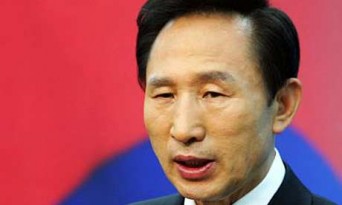
This would seem to be an attempt at placating members of the public who have expressed outrage at the lax response to not only the Yeonpyeong shelling but the sinking of the Cheonan back in March. In the last few days there have been some vociferous op-eds calling for the North’s “heads” this time. While others have voiced the general consensus that the ROK military needs to bolster its ranks and capabilities. If the reports about the military’s ineptitude and unreadiness are true, it is nonplussing since the Cheonan was sunk eight months ago in that same region.
In regards to the Cheonan, there are still doubts within Korea that it was sunk by the North despite a multinational investigation that provided extensive evidence. See here for the 3WM coverage of that controversy. One aspect of the skeptics argument was a number 1 that had been written on the torpedo that was determined to be the one used to sink the ship. Skeptics claim that the South Korean government somehow manipulated the evidence, perhaps writing the number on the torpedo that wasn’t even the real torpedo. North Korea also denied that it writes numbers on its weapons. Over the weekend, shells from the Yeonpyeong attack were also shown to have numbers written on them.
All the while it seems that advocates of the “sunshine policy” first applied under President Kim Dae-jung and continued under Roh Moo-hyun may be starting to waver after this latest attack. Ra Jong-yil, national security advisor under Roh Moo-hyun, refers to Japan before WW II while defending America’s presence in the region since the end of the war (yet, he also calls for some leadership within the region to hasten the U.S.’s departure).
China, in a two-step shuffle, has now implored that the 6-party talks members convene in Beijing as soon as possible to deal with the crisis and instability in the region. One could take this as offensive–a bit like being asked to meet with someone who just killed someone you care about on the day of their funeral–or as a sign that China wants to take the lead while dumping the emotional baggage to the curb.
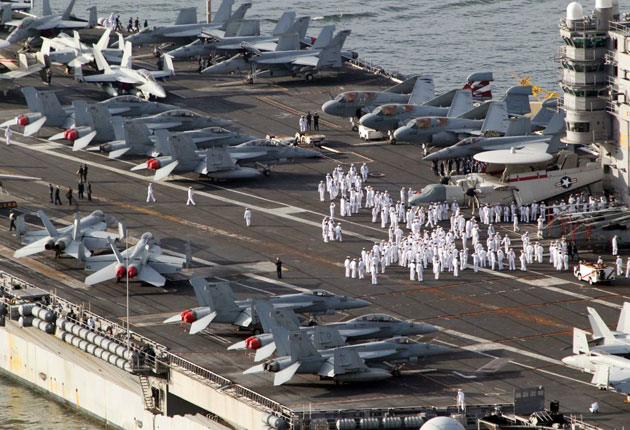
As military exercises neared there last day, Korean and U.S. forces practiced stopping ships suspected of transporting weapons of mass destruction which is part of the Proliferation Security Initiative. In addition, exercises to intercept enemy aircraft took place using advanced radar systems. The South’s Joint Chiefs of Staff (JCS) also said that exercises have been going on around the clock since the start on Sunday.
On a different note but no less significant, day-by-day U.S. diplomatic cables were released by Wikileaks revealing many confidential exchanges between embassies all around the globe. Of course, the cables related to North Korea have shined a light into the “black hole” of the region as diplomats apparently call it. David Sanger at the New York Times provides a good summary of the exchanges between China, the U.S. and South Korea which, essentially show more of what isn’t known than what is. Interestingly, despite his stroke, Kim Jong-il (aka KJI in diplospeak) still likes to knock ’em back and strikes fear into even top Chinese officials.
The Guardian is a ready source for the cables if you’re overwhelmed by the plethora of data at Wikileaks.

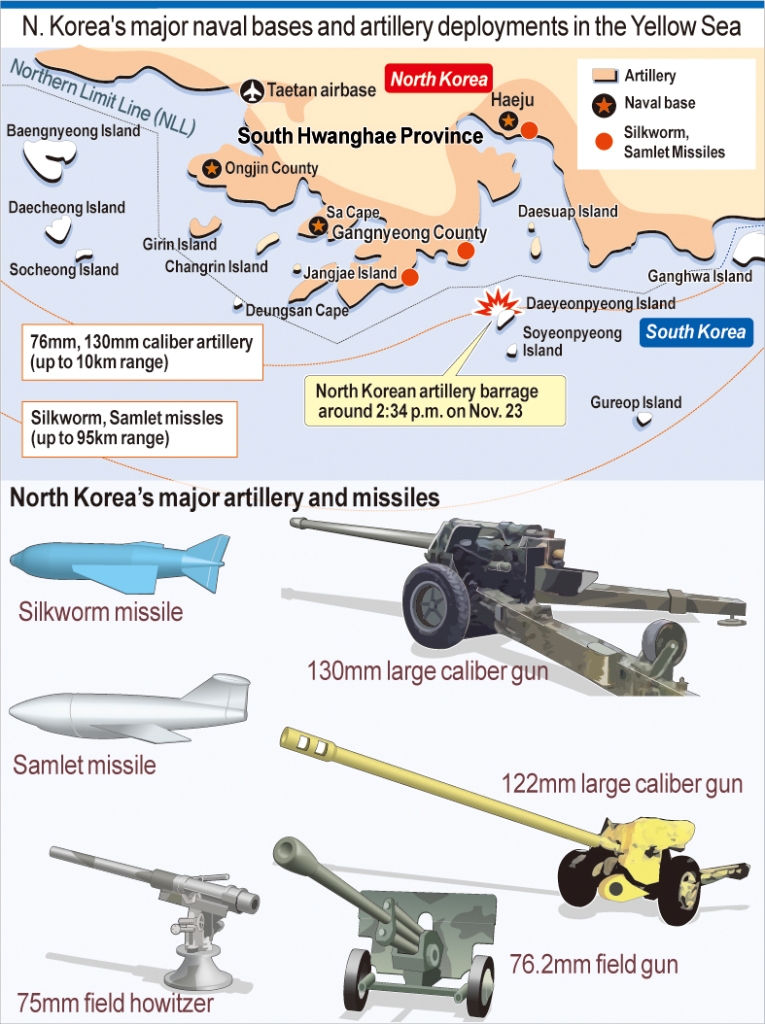
____________________________________________________________________________________________
 Print This Post
Print This Post





